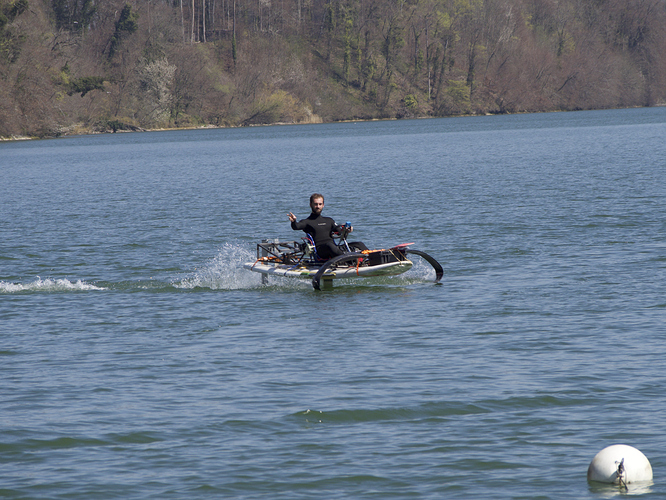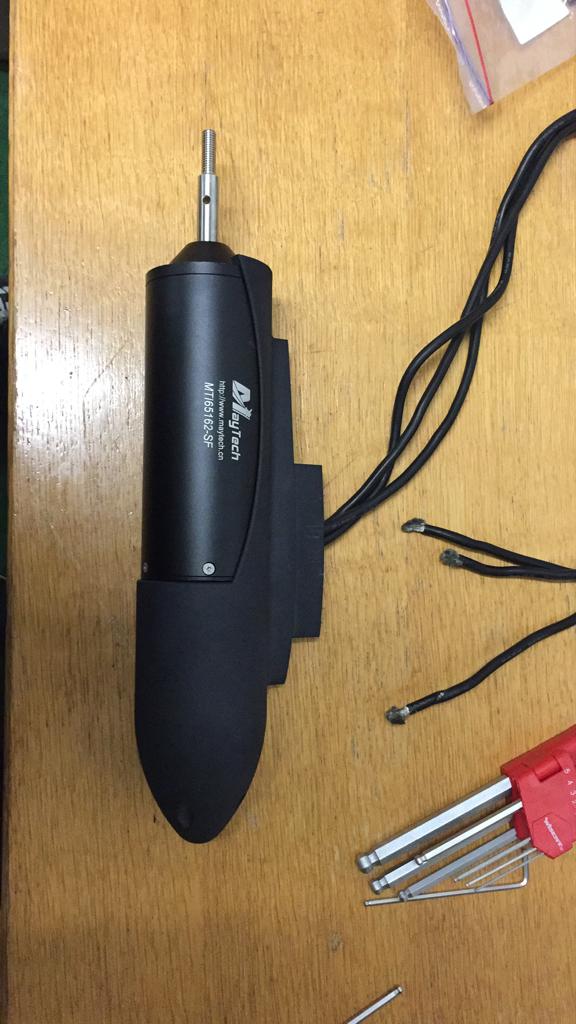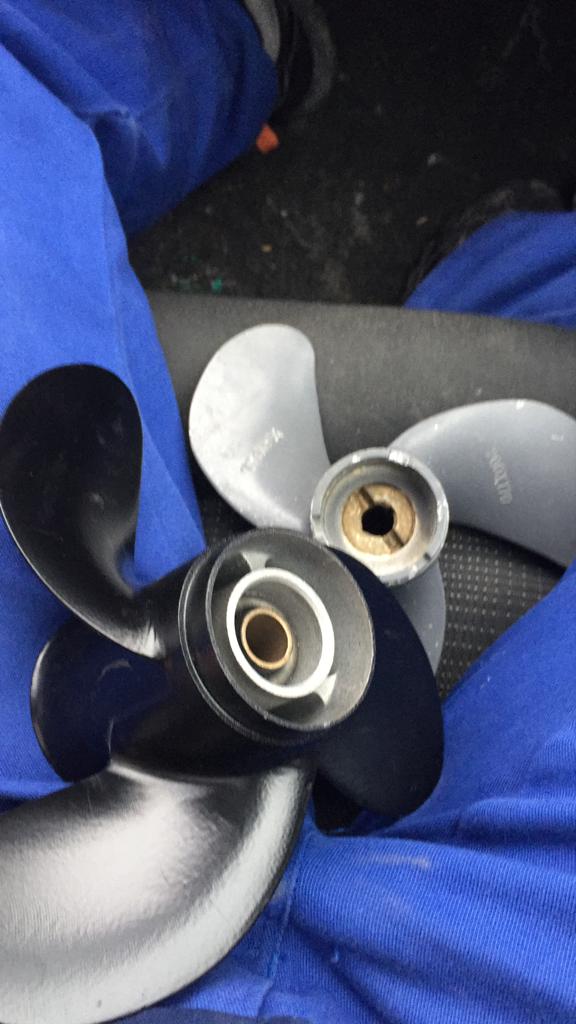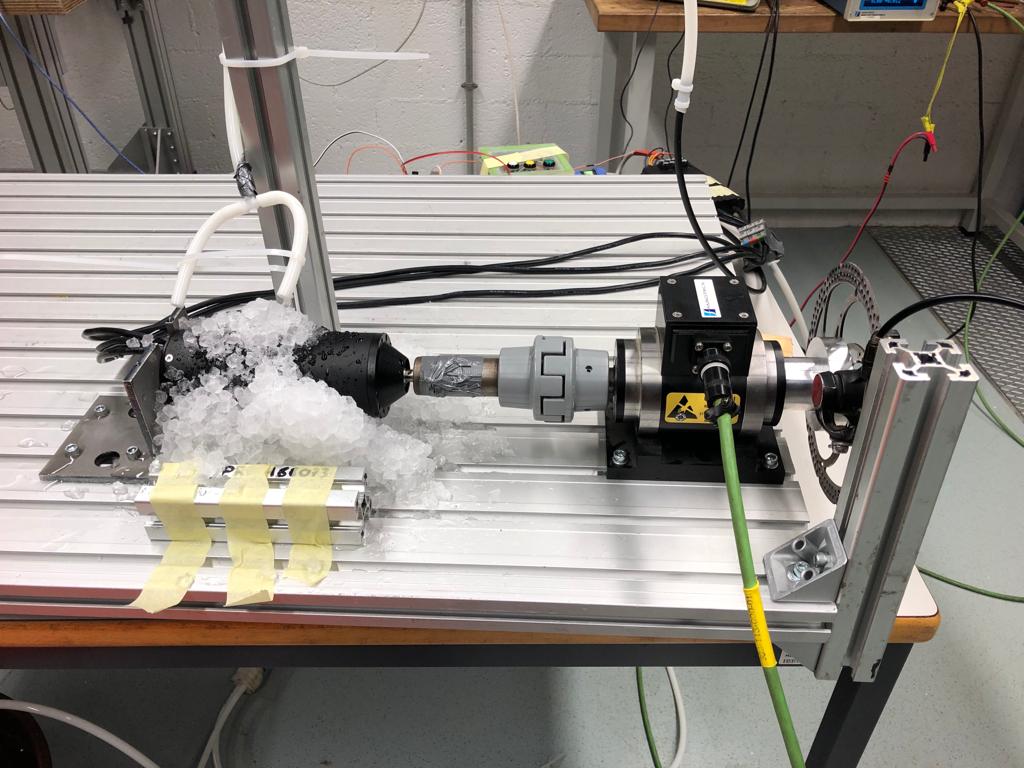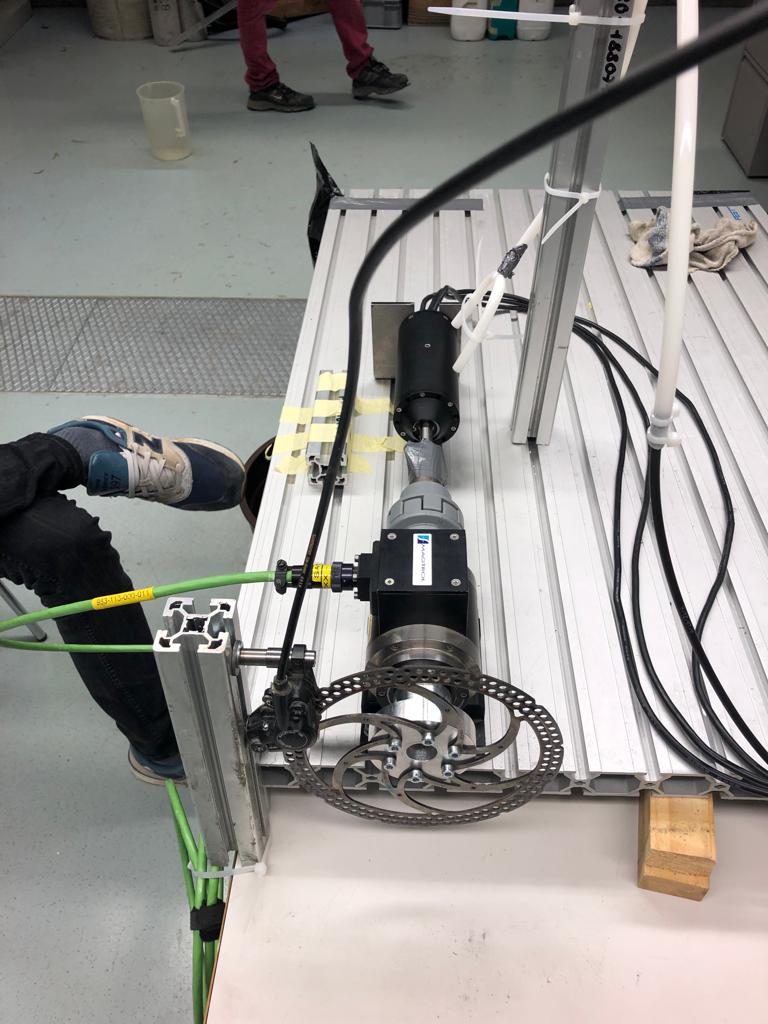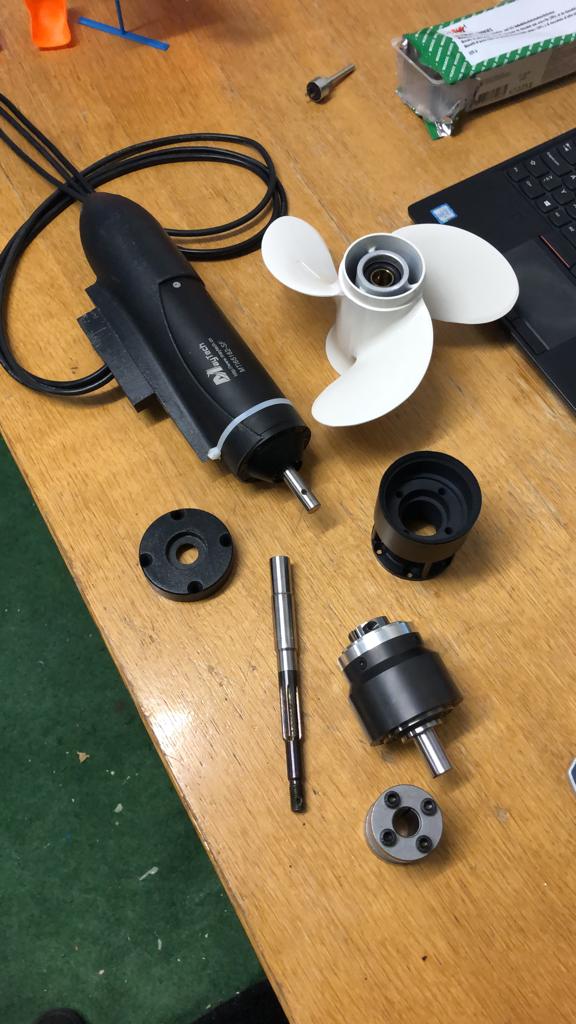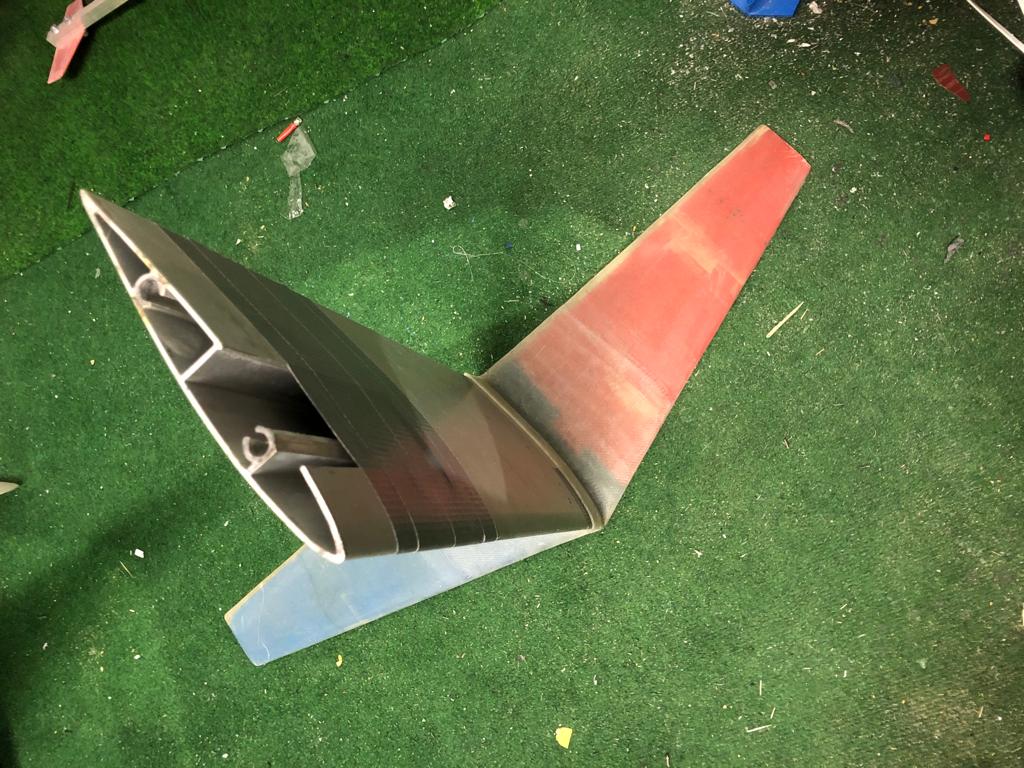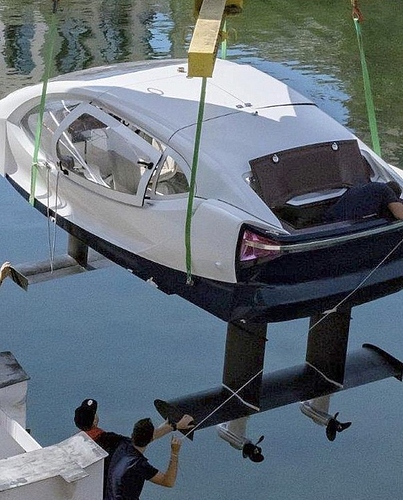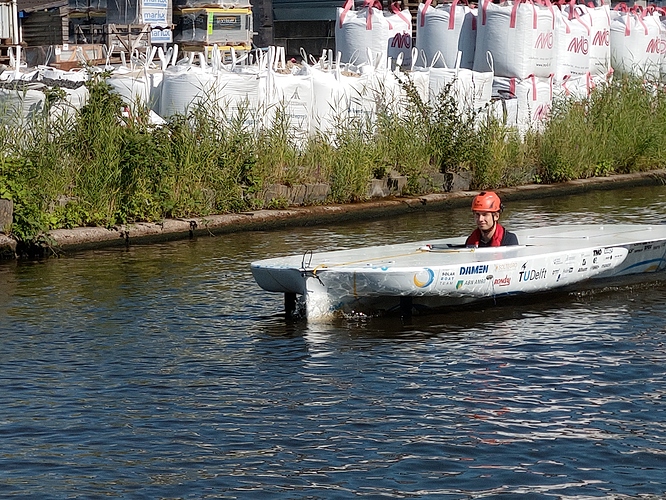This is our first prototype of a seated foiler. We started buidling it in october last year and we managed to make it foil in march this year  The board is a beginner windsurf board and we added a gokart frame on top of it.
The board is a beginner windsurf board and we added a gokart frame on top of it.
At first we had the motor under the rudder. Unfortunately it was applying to much force on the steering wheel and it broke our first rudder as well… That’s why we had to place it in the middle which isn’t the best configuration of course. This prototype weighed around 70kg.
We built our own batteries of 2.5kWh. They are 10s so it gives us batteries of 70Ah circa. We wanted to be able to fly for 30min. We had to divide them in two different waterproof cases because one battery was “recycled” and was difficult to modify.
First we bought the 140KV from Maytech. Burned that one. Than 190KV. Burned that one too. So we started thinking a bit and we bought the 100KV and tried several propellers with it (including the one maytech offers with it). We could’nt go faster than 15km/h and we needed to reach 20km/h to take off (maybe we are a bit heavy… ).
We started to engineer a little bit and tested the maytech motors (100KV and 190KV) beacause those guys can’t give you a real datasheet… Anyway we found out that the 190KV was more powerful than the 100KV (for same voltage, here 10s). Indeed 100KV would give us maximum 4kW and 190KV would give us 8kW !!
Thanks to the data we collected we were able o choose a propeller suited for our application on the 190KV. However we had to add a planetary gearbox so the propeller would be effecient. With these modifications we were able to foil and reach 30km/h ! 
Nevertheless I do not recommend to buy Maytech motors. They don’t know the product they are selling and they are very incoherent. We bought several motors and the shaft was always different so we had to modify our system each time. It is very frustrating to work with them and I think it’s sad that we cannot (or with difficulty) find another motor that suits efoils. The system motor-propeller they sell is very inefficient for efoil application…
Rudder foil is 3D printed and epoxy-fiberglassed. Front foils are 3D printed and epoxy-carbone vacuum fibered.
Hello, nice work! Why did you choose the wing configuration you have? Why not as a efoil with one mast and fuse and wing and stabilizer? Now you have 3 times watersurface cutting.
And can you give us more info about the power you need for flying etc?
Thanks
Toto
That’s a nice project !
What’s your actual gearbox reduction ratio ?
Have you considered simple SSS motor with Neugart gearbox instead ? You’ll get more torque with a 56123 420kV and a 1:4 or 1:5 reduction.
Plus you will have following advantages : cheaper, more power (56123 is 15kw capable, useful for takeoff), more torque (around 12-15Nm depending on your reduction gearbox), entire drivetrain can be waterproofed, you can use higher pitches props for higher speeds.
Worth reading for your project ![]()
Very interesting project. Every time I pass the old windsurf board in the back of my garage, I think of a project similar to yours but with two T-shaped foils at the front. How do you ensure self-stabilisation ?
There is another inrunner choice choice for you: the @Flying_Rodeo motor. Huge torque without gear in the 0-4500 rpm with 14s. 100% of satisfied and glowing efoil customers here. @ELEVATE.rocks sells them too.
[Edit] get a matching FR prop too, the most efficient for this motor.
Have you implemented the reverse or brakes, something efoil users don’t need as we can jump off the board ?
FR motor: 16 poles 18 slots in a 136 x 68 mm tube ---- Maytech 6 poles 18 slots
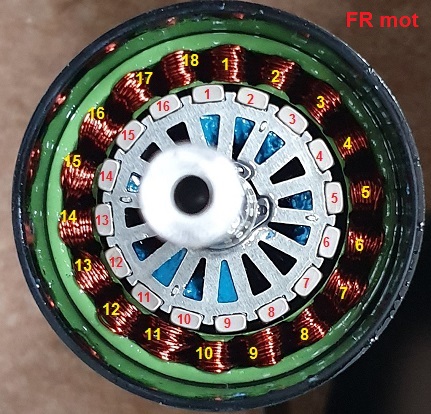
Solutions:
1: Use a higher voltage of 14S which will reduce the current needed to get the equivalent power out of the motor. You’ll burn less motors.
2: Stop using boat props designed for 2 stroke engines. They are not matched to these motors and are inefficient.
3: If your setup is heavy, then you are always going to need to gear it.
Toto44 is right. There will be loads of drag with all three masts in the water, and even more when the board is in the water.
A much better approach would be to use a high aspect wing in the front and then a decent stabiliser at the back.
Also use a board with very little rocker as it will get on the plane faster.
Actually it depends if the goal is to accommodate one or two seated persons that need to travel in a horizontal position.
What is true for a weight shift controlled craft (standing position, Evolo Project even a Moth) is not true for a craft using a seated rider looking for flight stability without possibility to move one’s weight. Imagine the Evolo project with a seat : possible but not comfortable at all. Worst still with two seats.
The stability of N-seated boats can only be got by spreading the lifting surfaces apart on the corners of a triangle (Tri-foiler, Hydroptere, Project Dared, …) or on the corners of a square (https://quadrofoil.com/ Slovenia) or two lifting planes with two pair of masts (Seabubbles, …).
IMHO a fuse is not suited for a N-seated craft.
Yes, three or four masts is less efficient than one but each can be 10mm-thick, and they won’t bent since two is always better than one ![]()
I don’t mind that you disagree, you are entitled to.
I don’t understand why you’ve added a second person though as from what’s been built they seem to be happy with one person on the board (plus a gokart can’t fit 2 anyway).
I’m also not talking about having the foil set up for weight shifted use (you assumed that). With this project you could use a mast in the front for a high aspect wing (they are super stable) and then a separate mast at the back with a large stabiliser that controls turning and pitch. That would already reduce drag.
Here’s the proof… https://www.youtube.com/watch?v=tvlS-4t54cc
Another massive weight save would be to get rid of the gokart frame…
You’re right but I don’t see the sales taking off without a two seater in the range to share the stoke ![]()
I mentioned the abandon of the fuselage for seated riders because:
1- Toto44 was suggesting the use of a fuselage that is not compatible with a seated riding position.
2- you didn’t mention two T"s in your post but nothing and a front wing and a big stab so implying a fuselage.
That’s a long lifting surface (2+m ?) not easy to transport
Two T"s are of course compatible (Moth’s, FoilKayak, Kotaro Horiuchi project as early as 2007 here below … and have often been used for one or two seats plus the strong bending forces on the single masts in the turns. That’s also why the J foil solutions have emerged (see quadrofoil example above).
That implies nothing about a fuselage, you made that assumption. If you read my initial post, I simply said Toto44 was right about the drag from "3 masts in the water and then I proposed a different wing setup.
That would be a lot easier to transport than a Quatrofoil (which is huge). Especially if it was cleverly designed and removable.
The 20mm Axis foil masts would be a great platform for a dual mast setup and strong.
While some of the other designs use J-foils and other types of foils, you cannot argue that the T-foil is much simpler and just as effective if you look at the new AC75 boats which only use 2 T-foils at a time when sailing.
I have some experience with this concept as well, focused on Big foil at the back and tiny foil in the front:
I have been a participant in the TU delft team in 2014 ( two foil concept ) :
And I am now in the Dutch Solar Boat team ( 3 foil concept, large rectangular black boat ![]() @2:10 below ) :
@2:10 below ) :
In my / our experience, where the small/big foil is placed depends on the weight shift contribution due to the acceleration / acceleration. In electric high powered boats such as solar boats in this example with about 7kW of engine power, the desire was for the two foil concept to have the small foil in the front. This was also practical for the weight distribution in combination with the hull shape ( large in the back → battery in the back ).
Ah coowl! This was probably still in the development / test phase, the PV panels seem to be missing. But they have switched back to 3 foils. I don’t know the exact motivation but from what I understood is was mainly for roll stability ( especially for side winds ).
TU Delft actually has electronically controlled foils which is very fancy and allow for super low drag racing. We still have a mechanical systems which has the advantage of being easy to repair when you are drunk  .
.
They used it to race last week. The official races were cancelled so they did a one day session on the Ketelmeer with 3 other boats I believe. The foils and struts which hold the gears with an engine in the hull is pretty cool!
